Pharm Exec’s 15th Annual Press Audit: The Opioid Crisis Dominates the News
The opioid crisis dominated the news in this year’s annual audit of press coverage of the pharmaceutical industry. Stephen J. Porth and George P. Sillup report.
For the second consecutive year, the opioid crisis dominated the news in our annual audit of press coverage of the pharmaceutical industry. The results of the fifteenth Annual Press Audit of issues in the pharmaceutical industry indicate that media coverage of pharma increased 12.8% from last year. The audit includes 132 articles from the top five selling U.S. newspapers, with coverage of the industry for the year up in three of the five newspapers. Two newspapers-the Washington Post and the New York Times-accounted for more than two thirds of the articles in the audit.
The increase in coverage of the industry was driven primarily by the number of articles on the opioid crisis which surpassed even its dominant position from last year, representing over 36% of all articles in the audit. In addition, high drug prices ranked second on the list of hot button issues, a perennial focus of attention. With these two topics garnering much of the focus of the major newspapers and media outlets, not surprisingly, much of the news was not good for the industry. Headlines were almost five times more likely to be negative than positive and full text articles were more than twice as likely to be negative than positive about the industry. The news was not as bad as it could have been for manufacturers in the industry, however, because some of the blame for high drug prices was shifted to the pharmaceutical wholesalers and intermediaries.
The annual audit sponsored by the Arrupe Center for Business Ethics at Saint Joseph’s University tracks and analyzes the industry issues covered by the media. Prior audits have found that media coverage is largely negative toward the positions taken by pharma. This year’s audit identifies the “hot button” issues attracting media attention in 2018, compares the issues and how they are covered to previous years, and reports on the pharmaceutical companies and brands most often cited in the news. We also updated our analysis of how healthcare reform has been reported by the press.
Some of the top findings for 2018 include:
- Coverage of the industry was up for the year to 132 articles, a 12.8% year over year but below the five-year average of 164 articles.
- Opioids dominated the news in 2018, emerging from obscurity just two years ago when it did not even register on the hot button list. Coverage of the opioid crisis grew from 42 to 48 articles year over year, and was the focus of 36% of all articles in the audit.
- High drug prices in the U.S. continues to be a major theme in the news, placing second on the hot button issues list for the second consecutive year. The focus on high prices increased from 24 to 29 articles, representing 22% of the articles.
- A new twist to some of the articles on high drug prices this year was the focus on the wholesalers and supply chain companies and their contributions to high prices.
- Next up on the list were the topics of Interaction with the Food and Drug Administration, and Research & Development for New Drugs.
- Drug Safety has been a perennial issue on the hot button list and was a focus again this year. Excluding the 48 articles focused on opioids discussed above, 13 additional articles focused on drug safety concerns.
- Healthcare Reform coverage decreased by almost 27% this year (from 75 to 55) with coverage in the New York Times down by almost 63%. Most of the healthcare reform articles, 69%, were neutral in tone.
- Media coverage of the industry has always been more critical than positive and that was true again in 2018. The good news for the industry, however, is that for 2018 the proportion of negative headlines and negative articles decreased slightly as further discussed below.
Processing the News
Once again, we analyzed the top five newspapers in the U.S. as defined by circulation for a 12-month period and identified all front-page and editorial articles pertaining to “hot button” pharma issues. The purpose of the audit was to shed light on the following questions:
- What ethical and legal controversies face the pharma industry-and what kinds of coverage do they attract?
- Do the articles and headlines support or oppose the positions taken by the industry, as defined by the Pharmaceutical Research & Manufacturers’ Association (PhRMA)?
- How often do reporters include the industry’s perspective in the stories that cover the issues of the day?
- What pharmaceutical companies and brand names are identified and discussed in the articles?
- What are the implications of these findÂings for the industry?
To be included in the study and in our EthicsTrak™ database,1 an article had to be published between October 1, 2017 and September 30, 2018 in one of the top five U.S. newsÂpapers (as measured by circulation)-USA Today, Wall Street Journal, New York Times, Los Angeles Times, and the WashÂington Post. It also had to (a) focus on an ethical or legal issue facing the pharma industry and (b) appear either as a front-page story or on the editorial page-an indicaÂtion of major news and public sentiment. Our emphasis was on daily newspapers because they provide in-depth coverage of a wide array of issues. To check how this aligns with reporting by other media, we again evaluated coverage by NBC Nightly News, All things Considered, and Google Trends.
For each article, we examined four elements:
Issues: We identified and categorized the hot-button issues that were discussed in each article. Many articles covered two or more issues that were included in relevant sections.
Headlines: We analyzed the headlines and categorized them as positive, negative, or neutral toward the industry. For example, “Drug Makers Profiteer from the Opioid Crisis” (USA Today, May 17, 2018), “Ravaged by Opioids, Tribe Fights Big Pharmacies” (New York Times, December 17, 2017), and “Pain Pill Distributors Offer a Bunch of Lame Excuses” (USA Today, May 10, 2018) were classified as negative headlines, while “Biotech’s Breakthrough Year” (Wall Street Journal, December 30, 2017) and “New Lung Cancer Study Shows the Power of Immune Therapy” (New York Times, April 17, 2018) were labeled positive.
Tone: We also analyzed each complete article to determine whether it took a positive, negative, or neutral position toward the pharmaceutical industry. For example, any article that called for restrictions or a prohibition on DTC advertising-a position that the industry opposes-was deemed negative. In contrast, an article that claimed that DTC advertising resulted in more informed patients was designated as positive from the industry’s point of view.
Balance: Regardless of the dominant position taken by the article, we also looked to see if the stories included the opposing point of view. When an explicit statement about an opposing view was included in the article-even if the two sides did not receive equal coverage-we concluded that the article covered both sides. When no mention of the opposing view was presented, the article was labeled as one-sided.
Figure 1 shows the number of articles for 2018 compared to previous years. Results indicate that the amount of coverage the industry received, 132 articles, was up 12.8% year over year but below the five-year average of 164 articles.
Figure 1. Number of Articles by Year
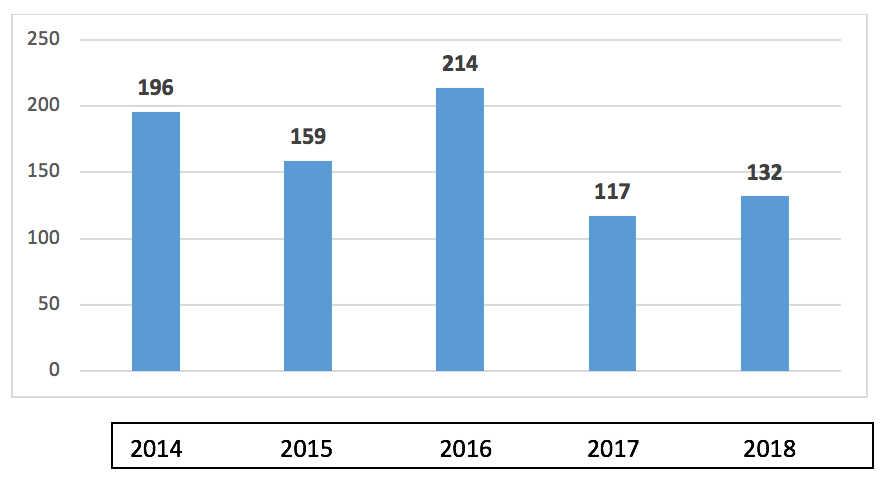
Table 1 shows the breakdown of coverage by newspaper. The increase in coverage for the year was due to more articles in three of the newspapers-USA Today (+15), the Wall Street Journal (+3) and the New York Times (+7). Coverage in the LA Times and the Washington Post was down by a combined total of ten articles. Despite less coverage in the Washington Post, however, it still ranked first among the five newspapers in coverage of the industry and together with the New York Times accounted for 67% of the total number of articles. The greatest increase in coverage, by a wide margin, was the jump from two to 17 articles in USA Today. Nine of those 17 articles focused on the opioid crisis.
Table 1. Number of Articles by Newspaper and Year
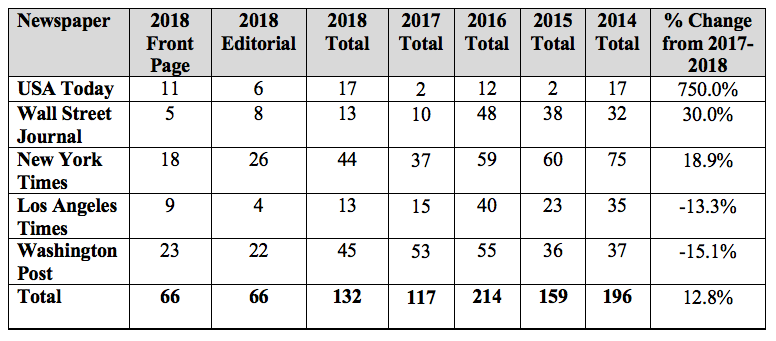
What are the Hot Button issues?
Figure 2 identifies the issues most frequently covered in the articles and the frequency of their coverage. The opioid crisis is the top issue on the hot button list for the second consecutive year. As recently as four years ago, opioids did not register on the list. In 2016 it skyrocketed to the second most frequently covered issue. In 2017 and 2018, opioids dominated the news, representing 36% of all articles in both years (42 of 117 in 2017 and 48 of 132 in 2018). Drug safety has been one of the topic issues on the hot button list since the inception of our audit but the opioid crisis has taken the issue to a whole new level of scrutiny. Combining the articles focused on opioids with others that focused on drug safety other than opioids (13 additional articles) and misuse and abuse other than opioids (an additional five articles), a staggering 50% of all articles focused on drug safety. This overwhelming focus reflects the heightened awareness and tragic consequences of opioid addiction. Some examples of these articles are “Too Little to Fight Opioid Abuse” (Washington Post, September 23, 2018), “A Vibrant Life, With Few Signs of the Addiction That Ended It” (New York Times, January 27, 2018) and “Doctors Fueled Opioid Crisis. Can They Help Cure It?” (USA Today, March 20, 2018). An example of an article on drug safety other than opioids was “Cancer Drugs Give Hope, But Side Effects Perplex” (Washington Post, January 3, 2018).
High drug prices in the U.S. is another perennial topic at the top of the hot button list, taking second place this year with 29 articles, up from 24 last year. More than one out of five articles (22%) that we tracked this year on the pharmaceutical industry discussed the high price of drugs. Examples include “Kids’ Health or Corporate Profits?” (Los Angeles Times, July 10, 2018), “The News on Drug Prices? Nothing Good” (New York Times, July 18, 2018) and “Jail for Shkreli Won’t Lower Drug Prices” (Los Angeles Times, March 15, 2018).
Figure 2. Top Pharma Issues in 2018 (# of articles)
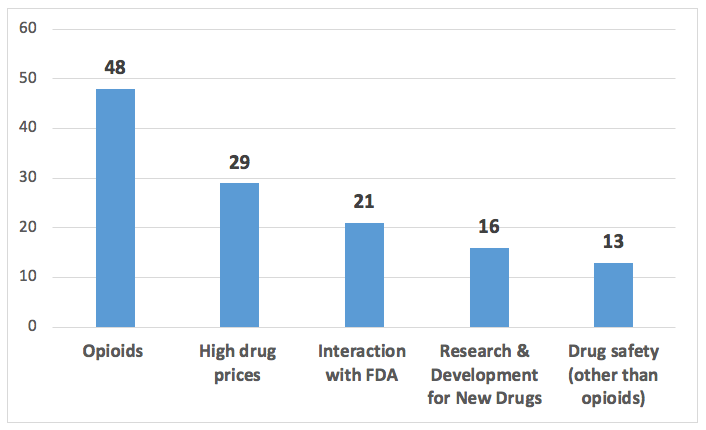
Again this year, we evaluated coverage of other media by looking at the coverage of three prominent media sources: NBC Nightly News, NPR-All Things Considered, and Google Trends. For opioids, the number of stories reported by NBC Nightly News more than doubled from 33 to 76. However, coverage by NPR-All Things Considered decreased substantially (40.7%) from 130 to 77. For high drug prices, NBC’s coverage decreased from six to two, and NPR reduced its coverage from 15 to eight stories. These findings are depicted in Table 2.
Table 2. NBC and NPR Coverage of Opioid and High Drug Prices

The data reported by Google Trends track how frequently a given search term is entered into Google’s search engine, relative to the site’s total search volume on that search term, over a given period of time. Google Trends can be used for comparative keyword research and to discover event-triggered spikes in keyword search volume. We tracked search volume from October 1, 2017 through September 30, 2018, the time period being studied for this article. The scores represent the relative search volume for a term or keyword so that a score of 100 represents the peak popularity of a term while a lower score, such as 50, means the term was searched at half the rate of its peak for the period (Rogers, 2016).
Google searches on the keyword opioids spiked at 100 during late October 2017, with searches decreasing over time to around 40 in November. It remained there until it spiked to 50 at the end of March 2018 after which it leveled to less than 40 through September 2018. This is depicted in Figure 3.
Figure 3. Google Trends Interest in Opioids; Click to enlarge.
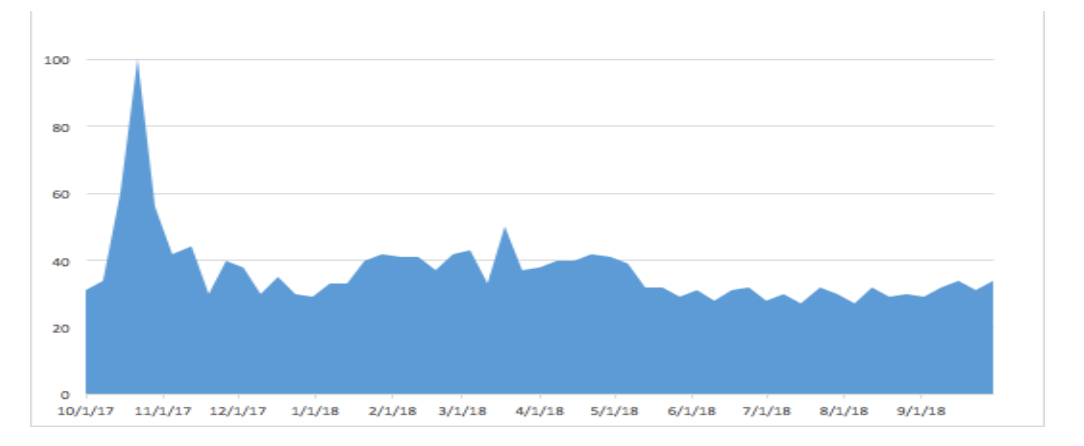
For the topic of high drug prices, Google Trends showed considerable activity throughout the year. Searches on high drug prices peaked at 100 on August 1, 2018, and included three spikes of 90 in November 2017, March 2018, and May 2018. High drug prices averaged a score of about 50 every other month during our reporting period. These findings are shown in Figure 4.
Figure 4. Google Trends: Interest in High Drug Prices Issue; Click to enlarge.
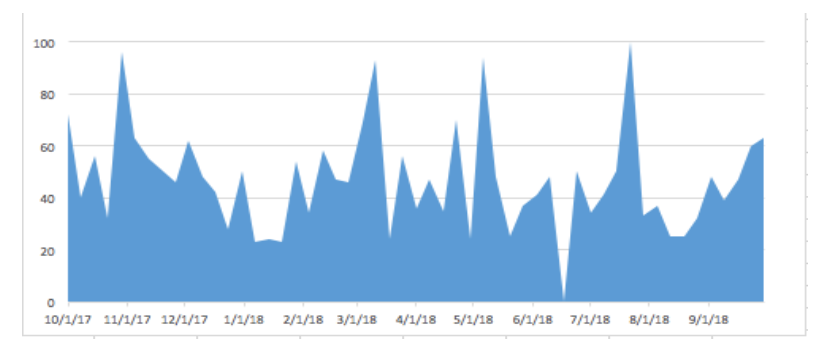
Linking the “Hot Button” issues and pharma companies
Pharma companies and/or their products were linked to the hot button issues for the sixth consecutive year. This year there were almost 6.5% fewer mentions than last year, 99 vs. 106. Of the 67 mentions, Novartis had 10 mentions largely due to their contributions to Michael Cohen. Purdue Pharma had eight due to the link between OxyContin® and the Opioid Crisis, and Pfizer had seven, largely due to its price increases. While the number of mentions about pharma companies and/or their products decreased, there were 32 mentions of eight integral participants in the pharmaceutical supply chain, such as drug wholesalers and pharmaceutical benefit managers (PBMs), which play a key role in the way prescription medicines get to patients.
After the pharmaceutical companies manufacture their products, they are transferred to wholesale distributors; stocked at retail, mail-order, and other types of pharmacies; subjected to price negotiations and processed through quality and utilization management screens by pharmacy benefit managers (PBMs); dispensed by pharmacies; and ultimately delivered to and taken by patients (Avalere Health Strategies Consultancy for The Kaiser Family Foundation, 2005).
The companies mentioned included very prominent drug wholesalers, such as McKesson and AmerisourceBergen, which accounted for 11 of the 32 mentions. CVS Caremark/Aetna had the highest number of mentions with nine, primarily due to CVS Caremark’s acquisition of Aetna. These eight companies represent an increase over the six companies (nine mentions) by those involved with the pharmaceutical supply chain last year and are depicted in Table 3.
Table 3. Pharmaceutical Supply Chain Organizations in the News
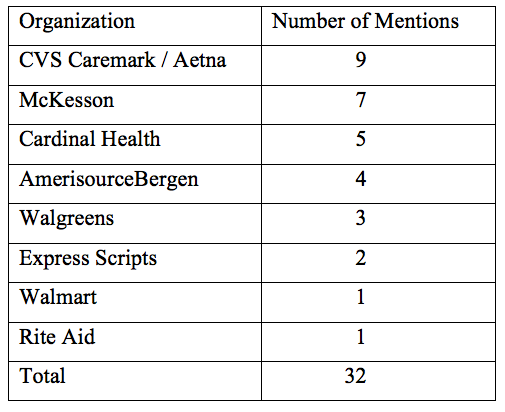
Coverage
Our 15-year audit has consistently found that the tone of headlines and articles tends to be more negative than positive for the industry. This finding persists in this year’s audit although there is a bit of good news for the industry. As described above, each headline in our database is categorized as positive, negative, or neutral for the industry. A five-year trend analysis of headlines shows a steady decline in the proportion of positive headlines which was relatively small to begin with. Figure 5 shows the trend, with positive headlines declining from 16.3% in 2014 to 7.6% in 2018. The bit of good news for pharma is that the proportion of negative headlines has also declined, down from 37.8% in 2014 to 34.1% in 2018. This means that more headlines are neutral in tone toward the industry, either because the reader would not know that the headline applies to pharma (e.g., “Who Will Help Puerto Rico?” Washington Post, September 4, 2018) or because the headline takes neither a decidedly positive nor negative stance toward the industry (“How to Fight the Opioid Crisis” New York Times, January 11, 2018).
Figure 5. Headlines Analysis (2014-2018); Click to enlarge.
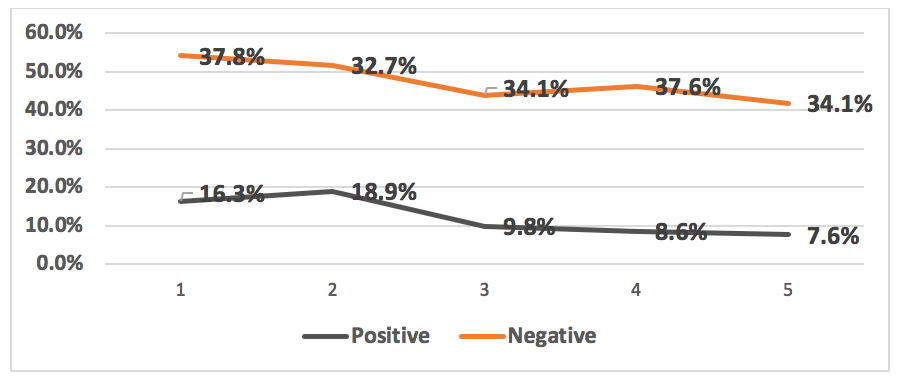
In terms of the tone of full-text articles, the trends are similar to the headlines analysis. As shown in Figure 6, the proportion of articles that takes a positive stance on pharma has declined from 29.1% in 2014 to 15.9% in 2018. Although the trend is down, it is not a steady decline.
Similarly, the proportion of negative articles is also declining, although not steadily. Figure 6 shows negative articles at 46.9% in 2014, declining to 38.6% in 2018. The implication of these trends is that over the past five years, articles on pharma are neither more positive nor more negative toward the industry, but tend to take a more neutral stance. Nevertheless, it remains the case that articles on pharma are more than twice as likely to be negative than positive toward the industry. Given the focus on the opioid crisis and high drug prices as the top two hot button issues covered in the press, this finding is not surprising.
Figure 6. Article Analysis (2014-2018); Click to enlarge.
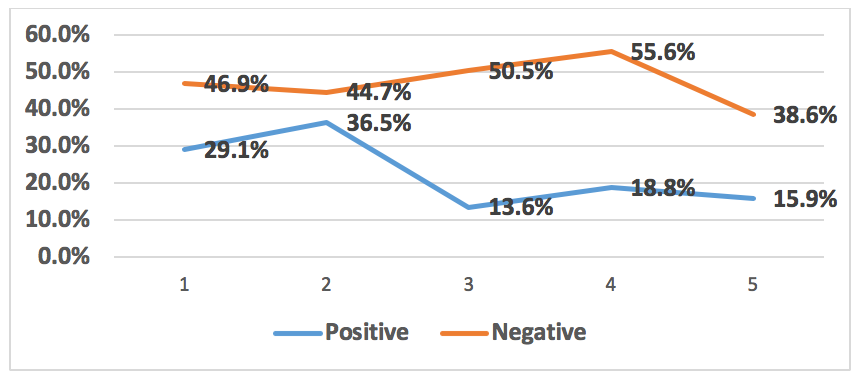
Regardless of whether the article takes a primarily positive or negative tone toward the positions of the industry, our audit analyzes whether both sides of the disputed issue are at least acknowledged. This year, 27.3% (36 of 132) of articles mentioned both sides, a decrease from last year’s mark of 32.5%.
Assessing this year’s healthcare reform coverage
Coverage of healthcare reform decreased by almost 27% this year (26.7%). Three newspapers, the USA Today, Washington Post, and New York Times, decreased; the New York Times dropped by almost 63% (from 35 articles in 2017 to 13 this year). Offsetting these decreases was the 300% increase by articles in the Wall Street Journal (from two to eight) and the 30% increase by the Los Angeles Times (from 10 to 13). Details are in Table 4.
Table 4. Number of Healthcare Reform Articles by Newspaper ; Click to enlarge.

Employing the same method used for our audits in previous years, we analyzed and answered the following questions:
- Do the healthcare articles and headlines support or oppose the positions taken by the pharmaceutical industry?
- What ethical issues does the pharma industry face in these articles?
- Are the pharma industry’s perspectives included in the articles?
- What pharma companies and/or pharma products’ brand names are identified in the articles?
- What are the implications of these findÂings for the pharmaceutical industry?
When the headlines and articles were analyzed as positive, negative, or neutral toward the pharmaceutical industry, the majority of articles were neutral, similar to results from other years. However, there was a decided shift in the number of articles categorized as neutral-from about 57% to 69% for all newspapers. This shift was true for all five newspapers. The shift to more neutral articles was also accompanied by fewer positive and negative articles for the newspapers except for the Wall Street Journal, which, at 37.5%, was the highest percentage of positive articles our analyses have had since 40% of the Wall Street Journal articles were positive in 2015. An example is the front-page article entitled "Big Health Deals Near Antitrust Approval" (September 6, 2018). Table 5 depicts the details.
Table 5. Five-Year Analysis of Healthcare Reform Articles; Click to enlarge.
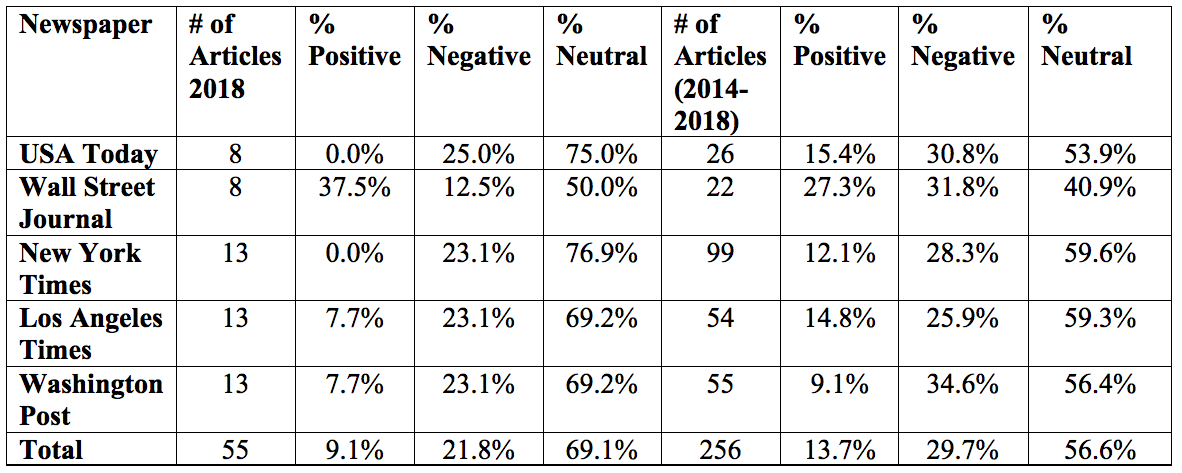
The top issue this year is again healthcare reform, the same as it has been for the last five years. Medicare/Medicaid is again the second most reported issue, primarily due to the attention being given to the concept of “Medicare for All” being discussed as a healthcare reform alternative. High drug prices has risen from fourth to the third most reported issue based on
attention it is getting in the media as well as on reporting about other factors that are contributing to the high drug prices. Details are in Table 6.
Table 6. Ethical Issues in Healthcare Reform; Click to enlarge.

For one of the few times since 2004 when we began reporting, this year’s findings are more favorable for pharma. Of course, there’s the usual negative attention the pharmaceutical industry gets for continuing to raise its prices; last year the price of 46 branded medicines decreased but 3,000 increased (Hamblin, 2019). However, this year the newspapers and media began to report about the way the pharma industry’s supply chain partners contribute to the high price of drugs. As part of recognizing how these other companies contribute to high drug prices, let’s follow the supply chain to understand how prescription medicines get to patients.
Favorable implications for pharma from this year’s audit
The pharma supply chain starts with the manufacturing of prescription medicines by pharmaceutical companies, which are shipped to wholesale distributors, such as CVS Caremark/Aetna and McKesson identified earlier in this article. Then, they are stocked at retail, mail-order, and other types of pharmacies where they are subjected to price negotiations and processed through quality and utilization management screens by PBMs, such as United Healthcare’s OptumRx, Express Scripts, and CVS Caremark/Aetna. The prescription medicines are dispensed by pharmacies directly to patients or delivered to them (Avalere Health Strategies Consultancy for The Kaiser Family Foundation, 2005).
When it comes to the opioid crisis, pharma has been a contributor but so have the other stakeholders in healthcare delivery; providers to include doctors, pharmacists, hospitals, as well as insurers and companies in the pharmaceutical supply chain, particularly PBMs. All have contributed to an almost three-fold increase in prescriptions for opioids over the last three decades, from about 76 million in 1991 to almost 214 million in 2016 (Brennan, Creager, and Polinski, 2017). This is four times the number of prescriptions in Europe and, alarmingly, resulted in 59,000 deaths for the same time period (Ibid.). PBMs have the opportunity to make a positive difference in curtailing opioid usage by leveraging their pivotal position in the prescription medicines’ supply chain, such as stepping up their retrospective utilization review programs to detect and intervene in unsafe prescribing of these addictive medications. Will they be the standard bearer for the 2016 guideline announced by the Center for Disease Control and Prevention (CDC), a Guideline for Prescribing Opioids for Chronic Pain, or will they emphasize the pursuit of profit from their three revenue sources: fees from the supply chain, rebates from manufacturers, and pharmacy “spreads”-the difference between what they pay for drugs from a pharmacy and what they get paid by the insurer (Arnold, 2018 and Ollove, 2019)?
Regarding healthcare reform, despite the pricing antics of others, pharma continues to make itself an easy target of scrutiny and criticism due to drug price increases. In an environment where the president has shifted from the dismantling of the Affordable Care Act to patchwork regulation, the pharmaceutical industry’s pricing of their products before they go into their supply chains continues to draw attention and has become one of the president’s favorite targets (Hamblin, 2019). Meanwhile, media coverage has broadened its focus to include the pharmaceutical industry’s supply chain and its role in contributing to high drug prices.
Works Cited
Arnold, J. (2018). John Arnold: Are Pharmacy Benefit Managers the Good Guys or Bad Guys of Drug Pricing? First Opinion, August 27. Accessed on 6 June 2019 at: https://www.statnews.com/2018/08/27/pharmacy-benefit-managers-good-or-bad/.
Avalere Health Strategies Consultancy for The Kaiser Family Foundation (2005). Follow the Pill: Understanding the U.S. Commercial Pharmaceutical Supply Chain. Accessed on 3 June 2019 at https://avalere.com/research/docs/Follow the_Pill.pdf.
Brennan, T., Creager, R. and Polinski, J.M. (2017). Pharmacy Benefit Management of Opioid Prescribing: The Role of Employers and Insurers. Health Affairs Blog, Sep, 21 DOI: 10.1377/HBG20170921.062092. Accessed on 2 June 2019 at: https://www.healthaffairs.org/do/10.1377/hblog20170921.062092/full/.
Hamblin, J. (2019). Has Trump Actually Done Anything About Drug Prices? The Atlantic May 10. Accessed on 7 June 2019 at: https://www.theatlantic.com/health/archive/2019/05/trump-actually-decreasing-drug-prices/589096/.
Ollove, M. (2019). Drug-Price Debate Targets Pharmacy Benefit Managers. Stateline Article February 12. Accessed on 3 June 2019 at: https://www.pewtrusts.org/en/research-and-analysis/blogs/stateline/2019/02/12/drug-price-debate-targets-pharmacy-benefit-managers
Rogers, S. (2016). What is Google Trends Data – and What Does It Mean? 1 Jul. Accessed on 22 June 2019 at: https://medium.com/google-news-lab/what-is-google-trends-data-and-what-does-it-mean-b48f07342ee8.
Reference
1. The EthicsTrak database contains assessments of 2,585 newspaper articles evaluated over a fifteen-year period.
Stephen J. Porth, Ph.D., is Arrupe Fellow & Professor, and George P. Sillup, Ph.D., M.S., Arrupe Fellow & Associate Professor, both of Saint Joseph's University (SJU), Philadelphia, PA. Cynthia Slater, SJU Business Reference Librarian and SJU Summer Scholar students, Caitlyn Landau, Kayla Herbert and Tyler Pham, also contributed to this research.
Regeneron, Roche Launch Major US Expansion Plans to Meet Growing Demand for Biologics and Innovation
April 22nd 2025With combined investments exceeding $53 billion, both companies are deepening their US presence through expanded biologics production, gene therapy capabilities, and next generation R&D centers.
Cell and Gene Therapy Check-in 2024
January 18th 2024Fran Gregory, VP of Emerging Therapies, Cardinal Health discusses her career, how both CAR-T therapies and personalization have been gaining momentum and what kind of progress we expect to see from them, some of the biggest hurdles facing their section of the industry, the importance of patient advocacy and so much more.